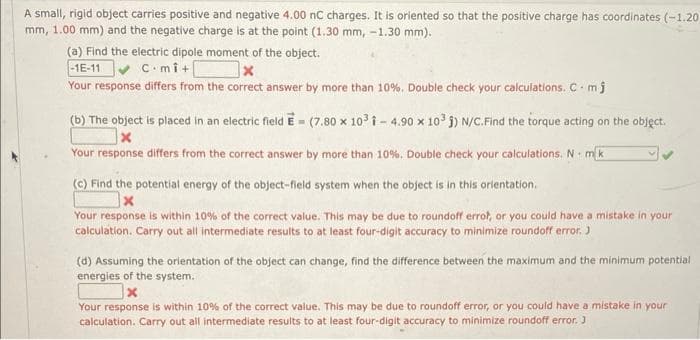A small, rigid object carries positive and negative 4.00 nC charges. It is oriented so that the positive charge has coordinates (-1.20- mm, 1.00 mm) and the negative charge is at the point (1.30 mm, -1.30 mm). (a) Find the electric dipole moment of the object. C-mi+[ -1E-11 x Your response differs from the correct answer by more than 10%. Double check your calculations. C. mj (b) The object is placed in an electric field E=(7.80 x 10³ 1-4.90 x 10³ ) N/C.Find the torque acting on the object. x Your response differs from the correct answer by more than 10%. Double check your calculations. N. mk (c) Find the potential energy of the object-field system when the object is in this orientation. x Your response is within 10% of the correct value. This may be due to roundoff errot, or you could have a mistake in your calculation. Carry out all intermediate results to at least four-digit accuracy to minimize roundoff error. J
A small, rigid object carries positive and negative 4.00 nC charges. It is oriented so that the positive charge has coordinates (-1.20- mm, 1.00 mm) and the negative charge is at the point (1.30 mm, -1.30 mm). (a) Find the electric dipole moment of the object. C-mi+[ -1E-11 x Your response differs from the correct answer by more than 10%. Double check your calculations. C. mj (b) The object is placed in an electric field E=(7.80 x 10³ 1-4.90 x 10³ ) N/C.Find the torque acting on the object. x Your response differs from the correct answer by more than 10%. Double check your calculations. N. mk (c) Find the potential energy of the object-field system when the object is in this orientation. x Your response is within 10% of the correct value. This may be due to roundoff errot, or you could have a mistake in your calculation. Carry out all intermediate results to at least four-digit accuracy to minimize roundoff error. J
Physics for Scientists and Engineers, Technology Update (No access codes included)
9th Edition
ISBN:9781305116399
Author:Raymond A. Serway, John W. Jewett
Publisher:Raymond A. Serway, John W. Jewett
Chapter23: Electric Fields
Section: Chapter Questions
Problem 23.11OQ: Three charged particles are arranged on corners of a square as shown in Figure OQ23.11, with charge...
Related questions
Question

Transcribed Image Text:A small, rigid object carries positive and negative 4.00 nC charges. It is oriented so that the positive charge has coordinates (-1.20
mm, 1.00 mm) and the negative charge is at the point (1.30 mm, -1.30 mm).
(a) Find the electric dipole moment of the object.
-1E-11 C-mi+[
x
Your response differs from the correct answer by more than 10%. Double check your calculations. C. mj
(b) The object is placed in an electric field E=(7.80 x 10³ 1-4.90 x 103 ) N/C.Find the torque acting on the object.
X
Your response differs from the correct answer by more than 10%. Double check your calculations. N mk
(c) Find the potential energy of the object-field system when the object is in this orientation.
x
Your response is within 10% of the correct value. This may be due to roundoff errot, or you could have a mistake in your
calculation. Carry out all intermediate results to at least four-digit accuracy to minimize roundoff error. J
(d) Assuming the orientation of the object can change, find the difference between the maximum and the minimum potential
energies of the system.
x
Your response is within 10% of the correct value. This may be due to roundoff error, or you could have a mistake in your
calculation. Carry out all intermediate results to at least four-digit accuracy to minimize roundoff error. J
Expert Solution
This question has been solved!
Explore an expertly crafted, step-by-step solution for a thorough understanding of key concepts.
Step by step
Solved in 4 steps

Knowledge Booster
Learn more about
Need a deep-dive on the concept behind this application? Look no further. Learn more about this topic, physics and related others by exploring similar questions and additional content below.Recommended textbooks for you

Physics for Scientists and Engineers, Technology …
Physics
ISBN:
9781305116399
Author:
Raymond A. Serway, John W. Jewett
Publisher:
Cengage Learning

Physics for Scientists and Engineers: Foundations…
Physics
ISBN:
9781133939146
Author:
Katz, Debora M.
Publisher:
Cengage Learning

Principles of Physics: A Calculus-Based Text
Physics
ISBN:
9781133104261
Author:
Raymond A. Serway, John W. Jewett
Publisher:
Cengage Learning

Physics for Scientists and Engineers, Technology …
Physics
ISBN:
9781305116399
Author:
Raymond A. Serway, John W. Jewett
Publisher:
Cengage Learning

Physics for Scientists and Engineers: Foundations…
Physics
ISBN:
9781133939146
Author:
Katz, Debora M.
Publisher:
Cengage Learning

Principles of Physics: A Calculus-Based Text
Physics
ISBN:
9781133104261
Author:
Raymond A. Serway, John W. Jewett
Publisher:
Cengage Learning

Physics for Scientists and Engineers with Modern …
Physics
ISBN:
9781337553292
Author:
Raymond A. Serway, John W. Jewett
Publisher:
Cengage Learning

Physics for Scientists and Engineers
Physics
ISBN:
9781337553278
Author:
Raymond A. Serway, John W. Jewett
Publisher:
Cengage Learning

College Physics
Physics
ISBN:
9781285737027
Author:
Raymond A. Serway, Chris Vuille
Publisher:
Cengage Learning